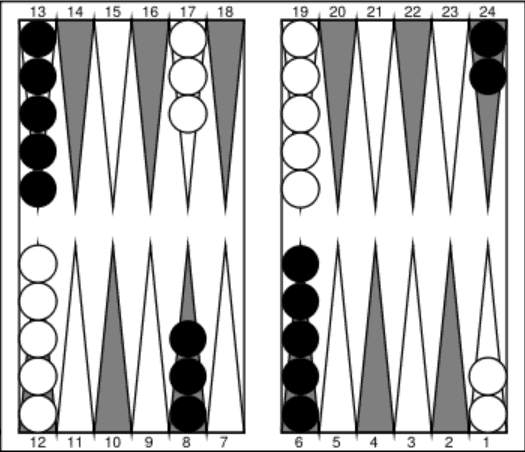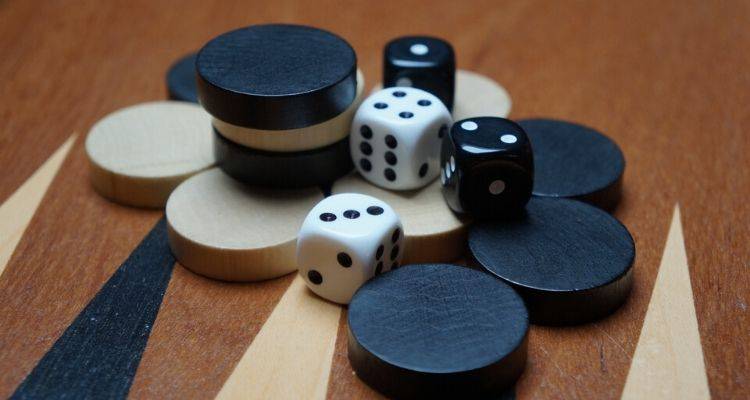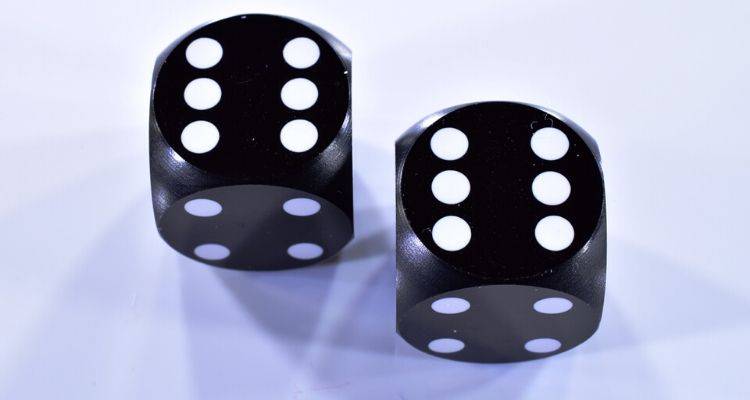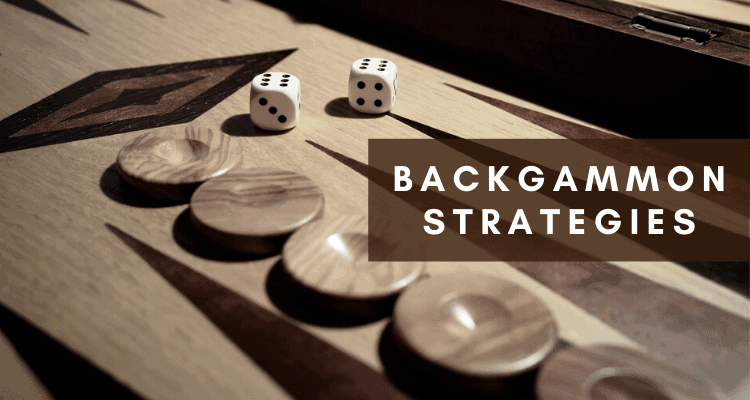Backgammon is one of the oldest and most admired board games, with a history dating back to nearly 5000 years. And if you’ve already played backgammon, you would have known how interesting it is.
But if you’re looking to play at a professional level and wondering how to improve your odds of winning, then you’re at the right spot, as I’m going to list some of the best backgammon strategies as well as other tips and tricks to help you master this game.
But before I get into the details, I would like to tell you a few things first. Keep in mind that backgammon is a game that combines both skill and luck.
If you consider the “luck” factor, it can make even the best players lose and even the worst players win.
According to Mikhail Tal, a former chess champion, and one of the world’s most admired players of all time said that he often watches the beginner lessons simply because it opens his mind to better ideas and also makes sure that he doesn’t forget the universal strategic principles, which are crucial to be successful in any game.
So, this means that even the most skilled players can lose if they fail to adhere to the game’s basic standards because these strategies are the universal and logical basics, which teach you a lot.
So, don’t underestimate the foundations of any game. Having said that let’s quickly get into the backgammon strategies now.
Backgammon Strategies you can Use when Playing
No matter what trick you use, your overall approach must involve 2 basic principles:
- Move the 2 pieces stranded in your opponent’s inner board.
- Prevent your opponent from moving his/her pieces of your inner board.
You can achieve them simultaneously. And if you do so, it will be the ideal situation for you to win the game. This basically involves 3 stages, which I’ve explained in detail below.
Understand that it’s a 3-Phase Game
So, the entire gameplay can be classified into 3 phases:
- Opening moves
- The middle game
- The end game
The was these phases start and end depend entirely on 2 factors:
- How you play
- How the game unfolds

Credit: Drexel iSchool
1. Opening Moves
Believe it or not, your opening moves play a very crucial role in determining how the rest of the game will progress. That’s why most experts will advise you to be more cautious while making your initial moves.
Here are some of the best first moves you can make:
- 6-5: This is also known as “Lovers Leap,” which lets you to move one of your back pieces into your opponent’s inner board to your midpoint, or your 13.”
- 6-4: Here, you can take 1 piece from the positions: 8 & 6 and cover 2nd spot in your inner board.
- 6-3: This allows you move one of your back pieces 6 space to the 18th point. This makes it safe as well as risk-free.
- 6-2: When you roll a 6 and a 2, you can easily move the 24th spot to the 18th in order to attack your opponent’s bar point. You can now use the 2 that you have rolled to shift your piece from the 13th spot to the 11th.
- 6-1: For creating a bigger prime as well as a blocking point (mainly to prevent your opponent from moving back his/her checkers towards his/her home board), form a bar point, which is more popularly known as the “seven point.”
- 5-4: If you roll a 5 and a 4, then move your 13th piece to position 8. Then, use the 4 to take any of your back pieces to the 20th position.
- 5-3: In this case, you can take pieces from spots 8 & 6 and merge them to cover your inner board’s 3rd spot. This truly makes a perfect first roll.
- 5-2: Here, you can take a piece from your 13th position and move it to the 8th spot. Since you’ve rolled out a 2, split the back pieces and take any one of them to the 22nd position.
- 5-1: Much like the above, you can take a piece from the 13th position and move it to the 8th spot. Since you’ve rolled out a 1, split the back pieces, and take any one of them to the 23rd position.
- 3-2: In this situation, take one of your pieces from the 13th position and move it to the 8th spot.
- 3-1: This is an awesome first move where you can cover your 5th position with pieces from your 8th and 6th spot.
- 2-1: This is an unfortunate roll. In this case, move one of your pieces from the 13th position to the 11th as well as move one of your back pieces with one space.
2. The Middle Game
The strategy for the middle game is a little unclear, as there aren’t any steadfast guidelines to conduct this game because the variations are a lot. Therefore, it is hard to describe when you’re in the middle game.
3. The End Game
So, this doesn’t start when all the pieces are in the inner board. Rather when clashes aren’t any longer possible. There’s a little trick involved in this game’s phase but any wrong move, can make you lose the game.
As far as the “end game” phase is considered, there are 2 huge mistakes that players often tend to make:
- One, using rolls to distribute the pieces across the inner boards.
- Two, moving a piece in the inner board when it’s possible to take off another.
The ideal trick is to take off as many pieces as you can with every roll. In the end, you’re entirely counting on the dice, but also remember that your opponent too is in the same situation!
Start by Blocking your Opponent
When you want to improve your backgammon skills and start to test with various tactics, especially while playing with real money, your overall goal is to always find a way to get your checkers around the board before your opponent does.
So, this means that you need to know the concept of “blocking” here, as it is one of the best ways to stop your opponent from progressing (to the bearing off-stage) quicker in the game.
Defend by getting 2 or more checkers onto a few strategic points across the board. Know that you’ll only need 2 checkers on a point to make it unattainable for your opponent.
Having 2 or more checkers on points prevents the other player from striking your blots, setting you back in the game. This means that you need to make the best possible moves to guard any weak points, which your opponent may try to hit.
Hit the Opponent’s Blots
So, if your opponent has blots (points with just 1 checker), hit (take) them. When you hit one of those blots, you’ll be forcing him or her to move the checker towards the bar and roll for a re-entry in the next turn. Now this consumes time and makes it tougher for him or her to progress in the game.
Bear Off Quickly
I’m sure you would have heard about “bearing off.” It is a term used when you have all the pieces in your home board, helping you to start moving them to your tray. So, the faster you get all your pieces to your home board, the higher the chances of winning the game.
Leverage your Opening Move
As I said earlier, the foremost move that you make has a huge impact, and even gives a hint if you’ll win the game or not.
While you might not be able to make a nice opening move whenever you play, it does help you know exactly what to do whenever the rolled dice is in your favour. Two of the most ideal opening moves that you can make are as follows:
- Create a Prime: For creating a prime, you’ll either need a 6-1 or a 3-1 & 4-2 dice roll. I will say that the 3-1 dice roll is the best. Why? Well, because you can make an anchor on the 5th point and thereby, helping you to create a prime using the 6th point. Now, this is a huge advantage since your opponent will have 2 (or lesser) probabilities of passing your bar.
- Create a Lover’s Leap: For this, you’ll need a dice roll of 6-5. Utilise these moves in order to bring your 24th point checker to the 13th point. So, this move will expose your other checker to make a hit, giving you a big benefit towards home.
The Strategy of Running Game
The goal of the Running Game strategy is to:
- Bring all the pieces to the inner board, and
- Bear them off soon
You should select a running game only when you have less pips left to get your checkers off than the opponent, and you’ve already gotten all those checkers past the opponent or perhaps, it seems likely that you can do so.
So, before you could think of engaging in this strategy, it is vital to assess the positions of your checkers and determine whether it is beneficial to apply this step. Let’s say that your opponent has lesser pips remaining, then, targeting at the running game strategy isn’t a good idea because it has lesser chances of winning.

The Strategy of Holding Game
This is another backgammon strategy for you to look into. So, the main idea of this tactic is to keep a point under your control, which is positioned highly in the opponent’s board – typically, a point in his/her inner board or actually the bar point.
Often, this is said to be the ideal strategy while trailing in the pip-count race. But trust me, playing this type of positional advantage is more like a style rather than a backgammon strategy.
Know that the bar points or 20 point are the finest holding game anchors because they give you supreme chances to strike your opponent when he/she brings his/her checkers nearer to home. Further, the points get weaker.
Also, it is important to comprehend the best time to offer the doubling cube (a strategy that I’ll soon explain to you), and to drop or accept a double while defending or playing a holding game.
A key strategic part of the holding game is to distribute the opponent’s checkers.
So, if he/she has made only the 8 & 13 points (in the beginning position), he/she will frequently have to leave a shot once he/she brings his/her checkers around. And if he/she has made extra landing points in his/her outer board, then your hitting probabilities go down considerably.
The Strategy of Priming Game
This strategy involves creating a prime — basically, an extensive wall of all your pieces, preferably 6 points in a row —to block your opponent’s pieces (the ones that are behind the wall) from moving.
So, these pieces will continue to be trapped as long as you sustain the prime. This, in turn, can create a fascinating struggle for the opponent to move his/her pieces on the board.
Note: The whole idea of applying the Priming strategy is to hit the opponent’s blots to trap them behind your barricade.
So, a prime can be created anywhere from point 2 to point 11 in your backgammon board. Then, you can shuffle it into your inner table as you approach the bearing-off game phase.
The Strategy of Backgammon Blitz
Backgammon Blitz is basically attacking your opponent’s pieces, with an intention to keep him/her on the bar while playing your pieces into the inner table as soon as possible.
The main goal of this strategy is to close one or more pieces of your opponent by seizing all 6 points in your inner table. When you do this, it makes it impossible for these pieces to come back to the game unless a point seems available when you’re bearing off.
Therefore, blitzes are committal—the moment you start to attack, you’ve to continue hitting and make changes to create additional points. However, if your attack fails, perhaps, because your opponent creates an anchor or you get multiple checkers hit, you can easily lose the game.
The main strategy to start a blitz is to roll early where you attack your opponent’s checker and he/she stays on the bar. Else, you hit 2 and he/she doesn’t enter both.
Note: Applying the blitz strategy isn’t a good idea if your opponent has already made lots of points in his/her board. Since you’re taking a risk to create points, you can’t afford to be hit. Also, it is important to double at the right time.
When blitzes succeed, they frequently result in gammons. Trust me, you can easily double if things go well.
The Strategy of Back Game
This is another backgammon strategy, which is attained by controlling your opponent’s 2 (or more) points in the inner table. The main goal is to hit a blot late and still contain it. Yes, this is a very difficult strategy to use because the possibility of success depends entirely on the outcome of the dice roll.
For the strategy of Back Game to be successful, it requires you to:
- Establish 2 anchors.
- Have at least 10 checkers advanced so that you can contain the opponent when you hit.
- Have adequate timing (far enough to be able to leave your opponent behind in the game) to wait until he/she rolls weirdly and leaves either a single or double shot.
Unless you are confident of using this strategy, don’t take a step because it can end you up in losing the game. Never use this trick if you’re significantly behind.

Understand the Probabilities of Backgammon
As I said earlier Backgammon is a game that combines both luck & skill. This means that it’s possible for any newbie to beat a professional if he or she is lucky with the dice. No wonder it attracts different players across the world.
And trust me, such precariousness cannot be found in other games like checkers or chess.
To improve yourself as a player, you should comprehend the luck factor better. Only when you have a good understanding of the numbers, you’ll have a clear idea of the right chances, and how you can position yourself to make the right decisions required to win the game.
The Possible Outcomes
Each die has 6 sides. So, this means that there are 6 possible outcomes, which ranges from 1 – 6. But when you roll 2 dice, you have 36 possible outcomes.
The (6 X 6 = 36) dice combinations are outlined in this table:
| 1,1 | 2,1 | 3,1 | 4,1 | 5,1 | 6,1 |
| 1,2 | 2,2 | 3,2 | 4,2 | 5,2 | 6,2 |
| 1,3 | 2,3 | 3,3 | 4,3 | 5,3 | 6,3 |
| 1,4 | 2,4 | 3,4 | 4,4 | 5,4 | 6,4 |
| 1,5 | 2,5 | 3,5 | 4,5 | 5,5 | 6,5 |
| 1,6 | 2,6 | 3,6 | 4,6 | 5,6 | 6,6 |
From these 36 dice combinations, your chances of rolling a doublet (example: double-5s) are the same, which is 1 in 36 or 35 to 1. Let’s say that you need 2 different numbers – a 2 and a 5. To achieve this, you’ve 2 possible combinations, which is 2 in 36, or 17 to 1.
Odds of Entering from the Bar Again
If you want to bring your checker to re-enter the game. But this also depends on the number of points your opponent has made. Keep in mind that this is only when you’ve 1 checker on the bar.
In the case of more than 1, the possibilities of re-entering 2 checkers increase considerably.
| No. of Blocked Points | Probabilities of Re-entry |
|---|---|
| 0 | 36/36 |
| 1 | 35/36 |
| 2 | 32/36 |
| 3 | 27/36 |
| 4 | 20/36 |
| 5 | 11/36 |
| 6 | 0/36 |
Being familiar with the probabilities, practicing regularly, and using the right strategies can increase your chances of winning.


